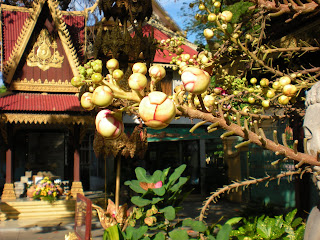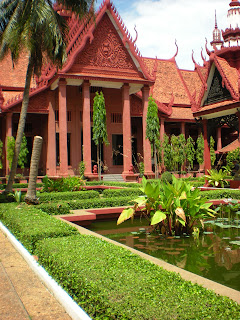During our time in Cambodia, we visited two places that are essential (but difficult) to see in in Phnom Penh. Both are a product of the genocide that occurred under Pol Pot’s regime in the 1970s, during which approximately 2 million Cambodians were killed. The first is Tuel Sleung (S21), a high school turned prison where political dissidents (including women and children) were held and tortured. The buildings at S21 contain the 2m x 0.8m prisoner cells, torture rooms/tools, photos of victims (before and after their detainment), and biographies of the perpetrators and prisoners. The building looks like any other school in the city, but is a chilling reminder of the atrocities that were committed in this country.
 |
| S21 |
 |
| Barbed wire to prevent prisoners from committing suicide |
The second location we visited was Choeng Ek Killing Fields, believed to be the largest in the country. These are located just outside the capital, where a memorial containing skulls and old clothing of victims now stands amidst mass graves. While many former S21 prisoners were eventually brought here to be killed, Killing Fields existed throughout the country during the genocide. While both places were difficult to see, they gave us a greater appreciation and understanding of the history and people of Cambodia.
 |
| Choeng Ek |
|
On the other hand, however, Phnom Penh seems to be moving past its brutal history, and retaken its place as the “Pearl of Asia.” We also visited The Royal Palace, Silver Pagoda, and National Museum, which depict the Khmer Empire at its pinnacle. The Royal Palace is a series of golden temples, monuments, and Buddha statues, with monks dressed in orange in most of the buildings. The National Museum holds artifacts retrieved from the Angkor Temples that we’ll be visiting next week, and had an interesting collection of statues and pretty courtyard. We’re happy that we were able to see the brighter side of Phnom Penh as it moves beyond its tragic past toward a promising future.













No comments:
Post a Comment